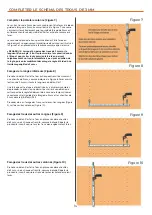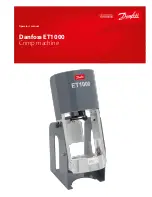
USEFUL TIPS
10
Figure 20
Figure 21
Figure 22
Figure 23
Figure 24
Making a Track Saw Cutting Station (Figure 20)
Making an Isometric MFT3 Top
Squaring a Finished top to the Hole Pattern
A track saw cutting station does not require very many
20mm holes. If all the 3mm holes created in the first part of
the process are converted to 20mm holes it is impossible to
add additional holes accurately at a later stage. Therefore it
is a good idea to design your layout so that there are sufficient
3mm holes left to allow the Parf Sticks to be deployed to create
additional rows or columns when required. There are also some
3mm holes required to complete the Triangular Methods which
do not subsequently need to be converted to 20mm holes.
Create the first line of 3mm holes following the method
shown in Figure 21. Then position two Parf Sticks as shown
so that they form an equilateral triangle with side 10 (96mm)
units each.
As the two Parf Sticks intersect in fresh air, use the Joining
Screw to fix them together makng sure that it fully engages
in both 6mm holes in the Parf Sticks. Then drill the holes
along the Parf Sticks indicated by the blue lines.
If you wish to ensure that your pattern of 20 mm holes is
parallel or square to the edges of your completed bench top
you can trim the top accordingly.
Place a pair of tall dogs, as shown in Figure 24, and place your
guide rail against them. Make a cut with your tracksaw to trim
off the unwanted part of the top.
If the line of the intended cut is such that the guide rail need
to be slightly further away from the tall dogs then use a piece
of stock of the appropriate width as a spacer.
Now place a Parf Stick in the position indicated on the right of
Figure 22 and secure, as indicated by “2”, using a pair of 3mm
Pins. Drill the 3mm holes and repeat on the left with the Pins
in position “3”.
Finally, complete the rows using a pair of 3mm Pins to
secure a Parf Stick in place using 3mm holes already drilled,
as indicated by “4” as shown in Figure 23 - always use a pair
which are furthest apart. This Isometric technique can be
used for larger bench tops.











































